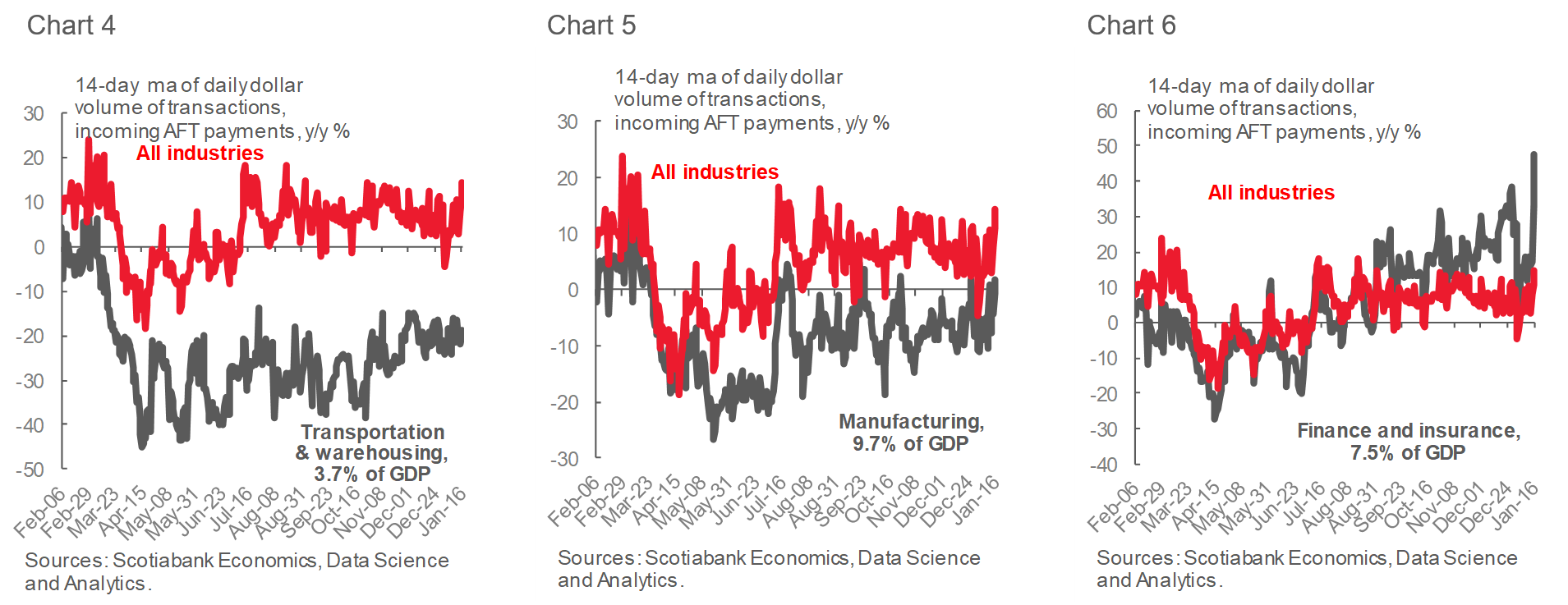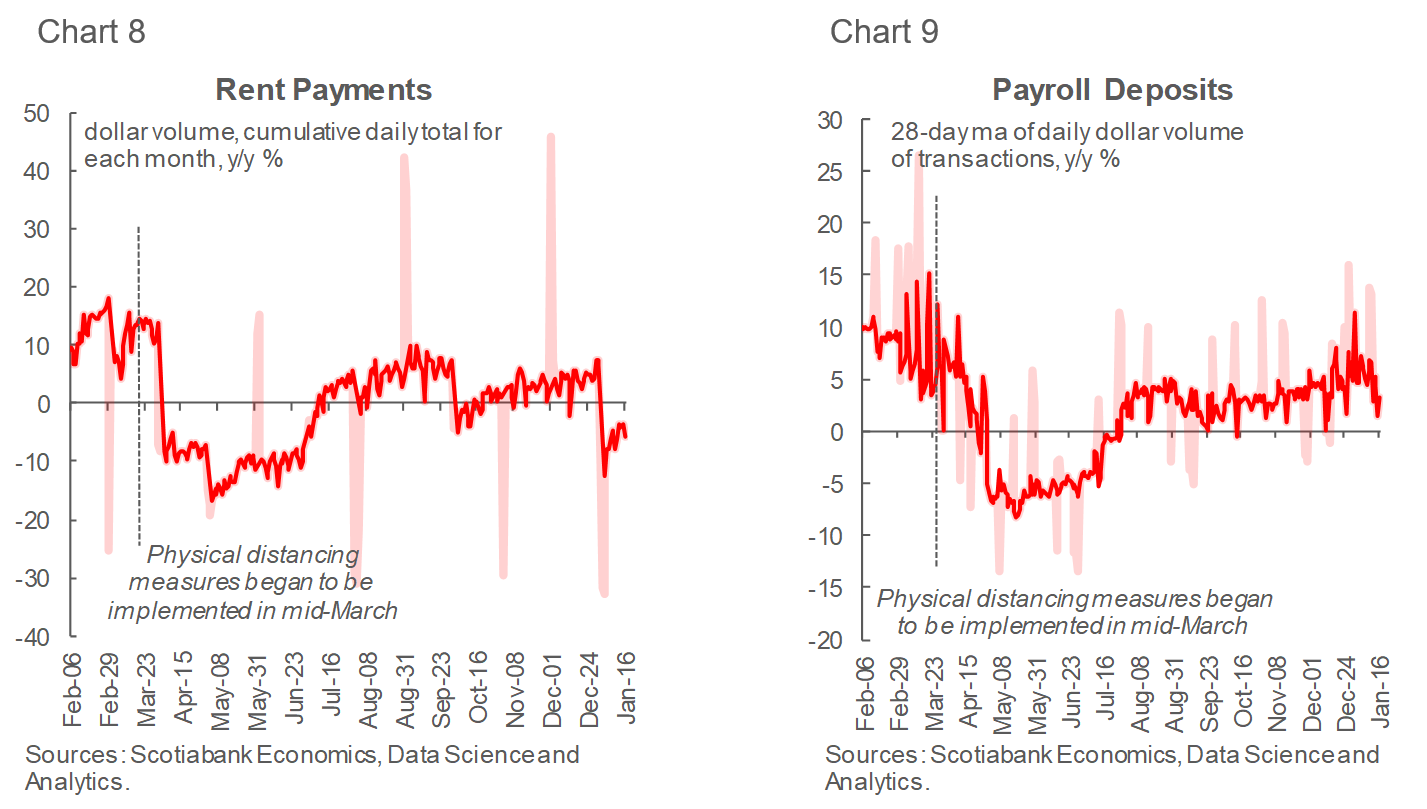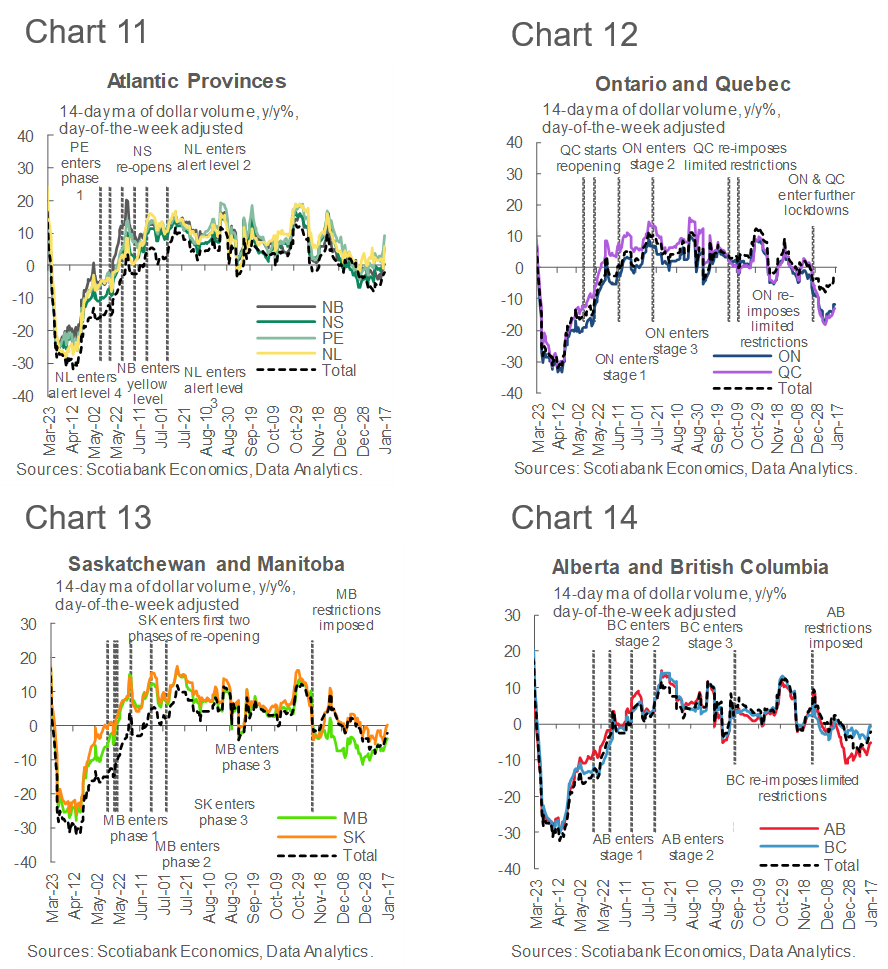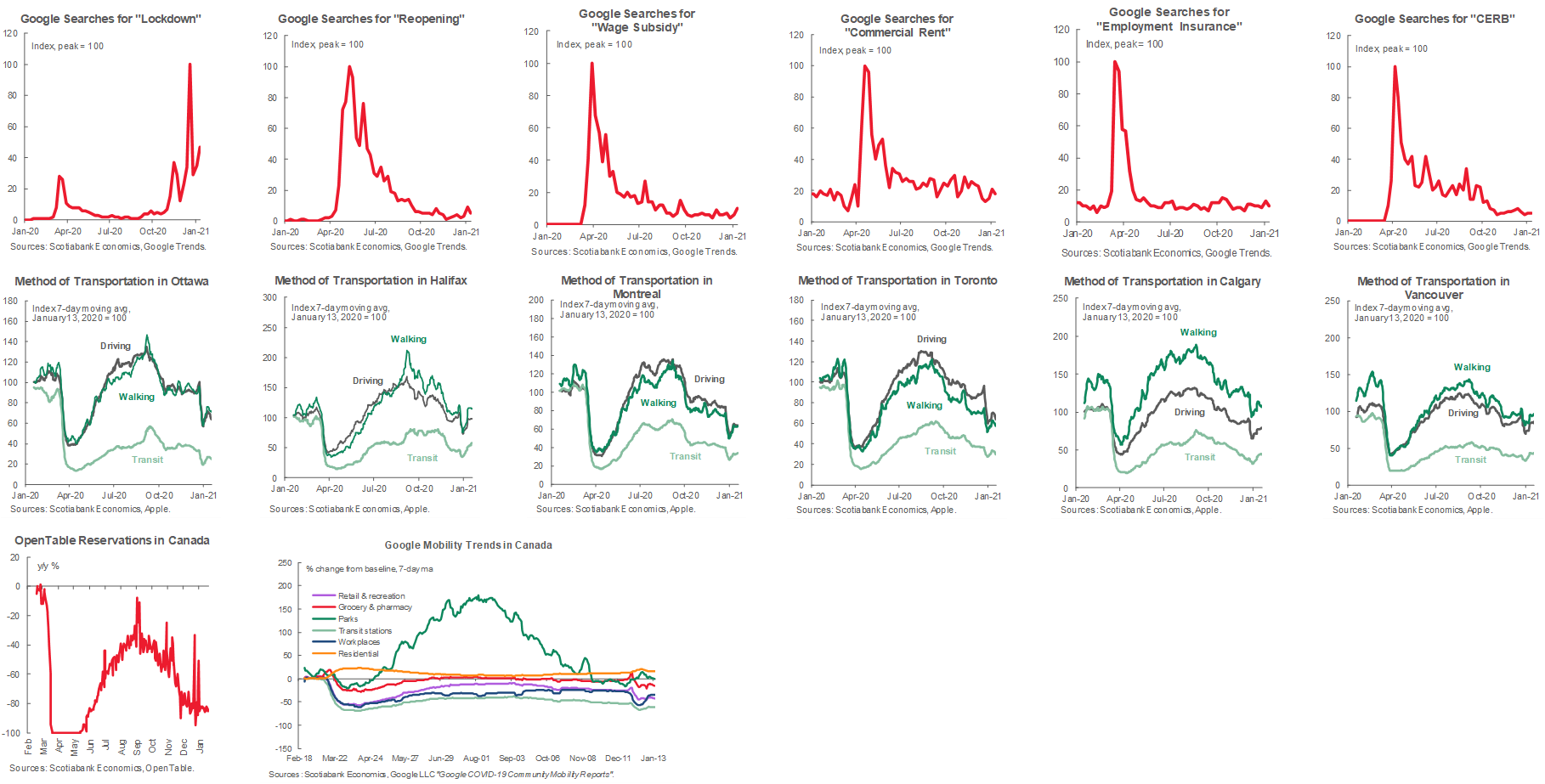Overview
- Key Insights from Customer Transactions
- COVID-19, the Canadian Economy and Scotiabank’s Transactions Data
- Business Transactions Data Details
- Retail Transactions Data Details
- Other High-Frequency Indicators of Activity
- Caveats
1. Key Insights from Canadian Customer Transactions
This presentation is part of the weekly series intended to draw insights about the state of the Canadian economy from the flow of Scotiabank’s retail and non-retail transactions data.
Key takeaways from the payments data in this week’s publication:
Updated to January 16th, y/y growth in business sector transactions picked up over the past week:
The financial industry saw a strong increase in y/y growth in incoming payments, and manufacturing firms received payments at the rate that was similar to that of a year ago.
Growth in overall outgoing payments, while it slowed somewhat since the introduction of new restrictions across various provinces in late December, remained positive. Rent payments, in contrast to payroll deposits, continued to run significantly below last year’s levels in January.
Following the conclusion of the holiday shopping season, consumer transactions continued to average close to the levels seen a year ago, pushing up y/y growth close to zero as of January 17th. The resilience in spending seen recently in January is perhaps a sign that the restrictions had their largest impact during the usually busy post-Christmas shopping season. The impact so far in January seems much more muted.
The improvement in growth seen nationally is also evident at the provincial level, with Ontario, Quebec, Alberta, BC, Saskatchewan and Manitoba all showing growth having bottomed out in early January.
Among the sectors we are tracking, activity picked up at online retailers, hardware and grocery stores in early January.
2. COVID-19 and the Canadian Economy: Scotiabank Transactions Data
We present data on retail and non-retail transactions, which capture distinct but related aspects of economic activity in Canada.
The data comprises actual observed daily transactions going through debit or credit card payment networks in the retail space, and automated funds transfers (AFTs) in the non-retail space.
The transactions are anonymized and aggregated to protect the privacy of Scotiabank’s clients.
The AFT payments show bill payments to/from companies in Canada.
Incoming payments can be associated with company revenue, and outgoing payments can be associated with costs.
Debit and credit card payments can be used to measure the evolution of retail spending at various types of establishments.
The transactions can serve as a measure of economy-wide retail spending, and of the extent to which households are resuming pre-COVID levels of activity.
Note that the use of electronic payments has increased because of COVID-19, so comparisons to year-ago levels can be misleading. These data are best used to observe directional movements rather than to make specific assessments on the level of activity.
In the current circumstances, comparing the dollar volumes of transactions in the current year to its level of a year ago should help track growth through the re-opening phase.
3. Business Transactions Data: Growth in Payments Jumped Higher in Mid-January
Updated to January 16th, y/y growth in business sector transactions picked up over the past week (chart 1):
The financial industry saw a strong increase in y/y growth in incoming payments, and manufacturing firms received payments at the rate that was similar to that of a year ago (charts 2-6).
Automated Funds Transfers (AFT) are used for:
rent and mortgage payments;
payroll deposits; and
other bills.

3. Business Transactions Data: Retail and Wholesale Payments Stabilized

3. Business Transactions Data: Manufacturing Payments Level with A Year Ago

3. Business Transactions Data: Growth in Bill Payments Remains Positive
Growth in overall outgoing payments, while it slowed somewhat since the introduction of new restrictions across provinces in late December, remained positive (Chart 7).
Rent payments, in contrast to payroll deposits, continued to run significantly below last year’s levels in January (Charts 8 and 9).
Rent payment slowdown is likely an indication of the impact of new restrictions on the ability of customer-facing businesses to pay rent. The recently launched Canada Emergency Rent Subsidy program will likely help to boost the flow of rent payments as the program’s take-up increases.

3. Business Transactions Data: Rent Payments Still Below Early-2020 Levels

4. Retail Transactions Data: Spending Growth Pushes Higher Recently
Following the conclusion of the holiday shopping season, consumer transactions averaged close to the levels seen a year ago, pushing up y/y growth close to zero as of January 17th. The resilience in spending so far in January is perhaps a signal that the restrictions had their largest impact during the usually busy post-Christmas shopping season. The impact so far in January seems much more muted (Chart 10).
Most of the negative impact on growth in December came from lower credit card spending.

4. Retail Transactions Data: Card Spending Bottoming Out Across Provinces
The improvement in growth seen nationally is also evident at the provincial level, with Ontario, Quebec, Alberta, BC, Saskatchewan and Manitoba all showing growth having bottomed out in early January (Charts 11-14).
Growth in the Atlantic provinces continued to outperform the national average in the last few weeks.

4. Retail Transactions Data: Spending Growth Improves Across Sectors
At the end of December growth decelerated in large part because of reduced spending on travel, clothes and restaurants, among other sectors (Chart 15).
The recent pickup was driven by stronger y/y growth in sectors outside of travel.

4. Retail Transactions Data: Hardware Stores See Stronger Spending Growth
Since the start if the year, growth bottomed out in several hard-hit sectors, such as clothing and entertainment. In addition, consumers continued to spend at hardware stores which saw y/y growth rise in mid-January (Chart 16). The latter is likely the result of continued strength in home renovations after a holiday-related pause.

4. Retail Transactions Data: Online Spending Picks Up Further in January
All merchants that saw a strong increase in demand over the course of 2020 saw a further rise in growth in the new year (Chart 17).
Spending continues to migrate increasingly online as the pandemic accelerated a pre-existing trend towards online shopping and on-demand delivery services.

5. Other High-Frequency Indicators Of Activity
Charts 18-31 Google Searches, Various Keywords, Dining and Transportation Data

6. Caveats
Note that the mapping from the volume of transactions to measures of economic activity (e.g. GDP) is imperfect, and so care must be taken when drawing the implications.
The data is observed at daily frequency and embeds different types of seasonal patterns.
For retail payments, the volume and types of payments are different depending on the day of the week and the season.
For non-retail payments, both the day of the week and the season are important. In addition, some payments are tied to the calendar date (e.g. rent payments are made on the first day of each month), some payments have a bi-weekly schedule, etc.
To smooth out most of the day-to-day seasonality we use a 14-day moving average of the dollar volume of transactions, taking a y/y% change to remove any remaining seasonal patterns related to the calendar date.
In addition to seasonality, there is normal payment volatility related to the random nature of the transactions process and the impact of regional and economy-wide events (weather, labour strikes, etc.).
The volatility of this nature may or may not be related to economic activity as measured by GDP and so, as mentioned above, care must be taken in drawing inference.
For business transactions, which are inherently more lumpy compared to retail spending, data towards the end of the sample can be revised as some AFT payments are recorded with a lag. As a result we exclude the last few days of data of business transactions only.
Nikita Perevalov* (Scotiabank Economics)
Taha Jaffer, Jason Liang (Data Science and Analytics)
Roland Merbis, Artur Motruk (Customer Insights & Analytics)
* Director of Economic Forecasting, 437.775.5137, nikita.perevalov@scotiabank.com
DISCLAIMER
This report has been prepared by Scotiabank Economics as a resource for the clients of Scotiabank. Opinions, estimates and projections contained herein are our own as of the date hereof and are subject to change without notice. The information and opinions contained herein have been compiled or arrived at from sources believed reliable but no representation or warranty, express or implied, is made as to their accuracy or completeness. Neither Scotiabank nor any of its officers, directors, partners, employees or affiliates accepts any liability whatsoever for any direct or consequential loss arising from any use of this report or its contents.
These reports are provided to you for informational purposes only. This report is not, and is not constructed as, an offer to sell or solicitation of any offer to buy any financial instrument, nor shall this report be construed as an opinion as to whether you should enter into any swap or trading strategy involving a swap or any other transaction. The information contained in this report is not intended to be, and does not constitute, a recommendation of a swap or trading strategy involving a swap within the meaning of U.S. Commodity Futures Trading Commission Regulation 23.434 and Appendix A thereto. This material is not intended to be individually tailored to your needs or characteristics and should not be viewed as a “call to action” or suggestion that you enter into a swap or trading strategy involving a swap or any other transaction. Scotiabank may engage in transactions in a manner inconsistent with the views discussed this report and may have positions, or be in the process of acquiring or disposing of positions, referred to in this report.
Scotiabank, its affiliates and any of their respective officers, directors and employees may from time to time take positions in currencies, act as managers, co-managers or underwriters of a public offering or act as principals or agents, deal in, own or act as market makers or advisors, brokers or commercial and/or investment bankers in relation to securities or related derivatives. As a result of these actions, Scotiabank may receive remuneration. All Scotiabank products and services are subject to the terms of applicable agreements and local regulations. Officers, directors and employees of Scotiabank and its affiliates may serve as directors of corporations.
Any securities discussed in this report may not be suitable for all investors. Scotiabank recommends that investors independently evaluate any issuer and security discussed in this report, and consult with any advisors they deem necessary prior to making any investment.
This report and all information, opinions and conclusions contained in it are protected by copyright. This information may not be reproduced without the prior express written consent of Scotiabank.
™ Trademark of The Bank of Nova Scotia. Used under license, where applicable.
Scotiabank, together with “Global Banking and Markets”, is a marketing name for the global corporate and investment banking and capital markets businesses of The Bank of Nova Scotia and certain of its affiliates in the countries where they operate, including; Scotiabank Europe plc; Scotiabank (Ireland) Designated Activity Company; Scotiabank Inverlat S.A., Institución de Banca Múltiple, Grupo Financiero Scotiabank Inverlat, Scotia Inverlat Casa de Bolsa, S.A. de C.V., Grupo Financiero Scotiabank Inverlat, Scotia Inverlat Derivados S.A. de C.V. – all members of the Scotiabank group and authorized users of the Scotiabank mark. The Bank of Nova Scotia is incorporated in Canada with limited liability and is authorised and regulated by the Office of the Superintendent of Financial Institutions Canada. The Bank of Nova Scotia is authorized by the UK Prudential Regulation Authority and is subject to regulation by the UK Financial Conduct Authority and limited regulation by the UK Prudential Regulation Authority. Details about the extent of The Bank of Nova Scotia's regulation by the UK Prudential Regulation Authority are available from us on request. Scotiabank Europe plc is authorized by the UK Prudential Regulation Authority and regulated by the UK Financial Conduct Authority and the UK Prudential Regulation Authority.
Scotiabank Inverlat, S.A., Scotia Inverlat Casa de Bolsa, S.A. de C.V, Grupo Financiero Scotiabank Inverlat, and Scotia Inverlat Derivados, S.A. de C.V., are each authorized and regulated by the Mexican financial authorities.
Not all products and services are offered in all jurisdictions. Services described are available in jurisdictions where permitted by law.

